|
TennisOne Lessons Pro Strokes within the Advanced Foundation Professional Strokes that you can emulate David W. Smith, Senior Editor TennisOne
Roger Federer’s game has been analyzed, scrutinized, and even glorified, over the last few years, and for good reason. I feel his forehand is one of the best models for anyone to emulate. It isn’t too extreme. It isn’t overtly flashy or flamboyant. It isn’t as heavy as a Nadal forehand, and perhaps it doesn’t have the potency of a Roddick or Blake forehand when Andy or James is playing well. But it is certainly one of the most consistent and penetrating forehands on the men’s tour. Last month, I used Nikolay Davydenko as a model for the two-handed backhand foundation. This month, I wanted to go on to the logical progression by covering the forehand in the same light. However, this time, I will also use my daughter Kyla in demonstrating the concept of how a beginner can use pro strokes to gauge their development and to see if they are establishing the principles of a solid foundation.
As I have said many times, a hundred people can learn the same stroke and no two will play exactly the same way. This is true even among the pros. Of all shots, the forehand offers probably the widest range of intricacies and idiosyncrasies even among pros. However, even within these individual characteristics, we can clearly identify the similarities within each player’s foundation. While Federer may not have the most outright potent forehand, it contains all the necessary elements for a solid foundation. Stance As with almost all pros, the open stance is the staple, aggressive set up used on the forehand. However, because of several key elements, the open stance is a tough way for any beginner to establish an Advanced Foundation. The first point is that an open stance must be accompanied by a strong unit turn. For beginners, the upper body tends to follow the hips and legs. Thus, when a beginner first learns the open stance, they tend to swing only with their arm and don’t get enough—if any—upper body turn during the preparation phase of the stroke.
I prefer beginners to learn a neutral or closed stance as this helps facilitate the unit turn. This is not a transitory learning step, however. All pros hit neutral and closed stances, especially when hitting on the run or in other specific situations. Thus, it is a shot that must be learned and presents a better footwork method to introduce beginners to. It is also very natural to progress to the open stance forehand once the swing pattern and topspin stroke have been established as I will demonstrate with Kyla in a moment. One and Two-handed Forehand Stroke As I have mentioned in previous articles, the two-handed forehand is one of the best methods for players to establish excellent advanced form. I have seen so much success with this stroke in developing top players, adults, and juniors alike, that I recommend teaching pros explore the understanding and teaching of this stroke.
As you will see, Kyla’s two-handed forehand mimics many of the swing elements that Federer and all pros use. She hits it with excellent pace but more importantly, for an 8-year old, she hits with significant topspin. This factor is key in any forehand since the ability to hit harder, more angles, and more finesse are rooted in the player’s ability to hit topspin. It is also relatively easy for players to switch to one handed swings when they feel the time is right or feel the need to do so. Kyla enjoys hitting one-handed forehands but does not have the means to hit it with repetitive consistency. I see this among many juniors training in various environments. They are taught to swing one-handed and but can’t hit cleanly nor consistently with the same stroke pattern on command. Consequently they develop many bad stoke habits because of the perceived weakness in their swings. They use too much wrist, rotate their body too early, and seldom develop a repetitive swing pattern. Two hands provides a stable swing pattern that makes it much easier to established key swing elements as well as balance and footwork patterns associated with movement to the ball.
Swing Pattern As with most pros, the initial unit turn is usually accompanied by both hands following the racquet back. Some players hold on longer during the back swing, others a bit shorter. But, the emphasis is that the body makes the coiled turn, not the arm simply taking the racquet back. (The common teaching phrase, “Get your racquet back” should emphasize the element of taking it back with the upper body, not just the arm swinging it back independent of the core of the upper body.) I don’t teach a specific loop backswing as I have found that all students will evolve or develop a loop backswing that works for them. It is rare indeed, that I address the loop swing for any player. I will, however, on rare occasions introduce a student to the loop if I feel they have not explored the loop on their own. Kyla is developing a small loop on her take-back, but remains compact and manages to get well below the ball early enough to hit with ample topspin. She will most likely begin to take a bigger loop backswing as she becomes more aggressive. The progression I prefer is to develop the stroke mechanics first, then add speed to the swing as well as more and more complex and demanding footwork patterns. As with most professional forehands, the hitting elbow comes into the "slot" of the waist, (dropping down from the high point of the backswing down near the waist), and then extends out as the arm moves through the hitting zone. Depending on the desired topspin, the racquet head will drop accordingly prior to the contact phase. It is this moment where the elbow comes into the slot and the racquet head drops that creates what we call the “pre-stretch” of the forearm which generates excellent racquet head speed. (Please see Vic Braden’s “Pre-stretching the forearm on the forehand” article for more information on this.)
Notice the hitting hand of Federer leads the butt-cap of the racquet first followed by the pre-stretched forearm and then the racquet head. With semi and full western grips, contact will be made more out in front of the player than with an eastern or continental grip forehand. The top edge of the racquet accelerates up and through the ball from the whip factor that was initiated back when the racquet head dropped and the hitting hand began to move forward. Players will want to focus on the top edge of the racquet, imagining it leading the way throughout the stroke. Too many players roll this edge over or flip the tip of the racquet around the ball. These types of movements change the racquet face in the critical contact phase of the swing and as such, those who do this will seldom have consistent or accurate forehands. The follow-through can be one of four variations. We see pros finish with the “reverse” follow-through, (where the racquet hand comes up over the hitting arm’s shoulder), the high over the opposite shoulder, level around the opposite shoulder, down below the opposite shoulder and even lower still, down around the lower, opposite hip. Look for the finish of the hitting elbow pointing towards the target. This is a good key-position point that usually tells you whether you are finishing correctly. Also, a higher elbow finish often helps add more topspin to the forehand.
Footwork
As I mentioned, I like the closed stance as the initial learning pattern for footwork. However, you can start kids of any age on open stance forehands once they have developed a competent forehand stroke. The open stance forehand is all about loading the inside foot, getting good upper body coil (unit turn), and then "exploding" the hips into the shot. However, players need to be careful about over rotating the hips or rotating them too early. This will cause the player to be too far out in front of the swing and, as a result, they will decelerate the swing to maintain trajectory with the desired target. Watch the loading of Federer’s inside (right) foot and the pivot of his hips over this foot as he drives up and out through the ball. Yet, observe too, how the hips then nearly stop completely this rotation and allow his racquet to catch up and then whip through the contact zone. You might be able to see some of the swing components in Kyla starting to evolve. Recovery Steps There are several recovery steps that are employed by all good players. These include the following:
Conclusion Your comments are welcome. Let us know what you think about Dave Smith's article by emailing us here at TennisOne .
|
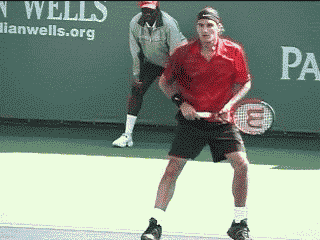
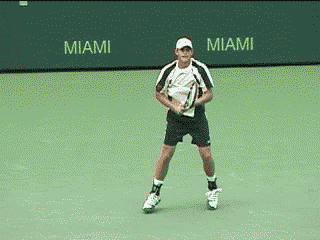
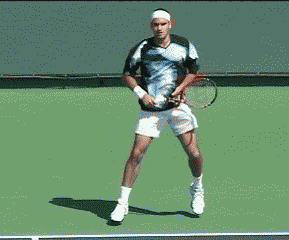
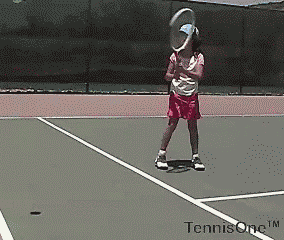
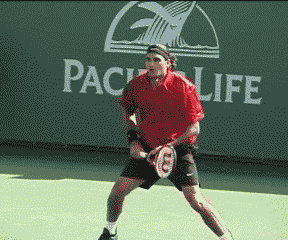
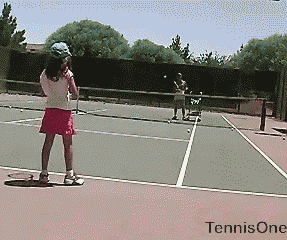
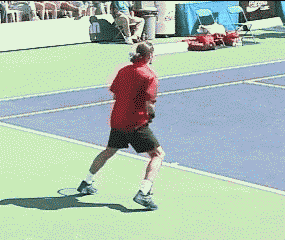
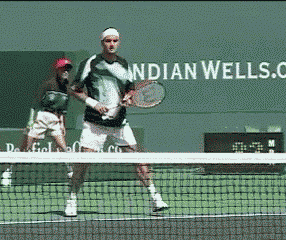
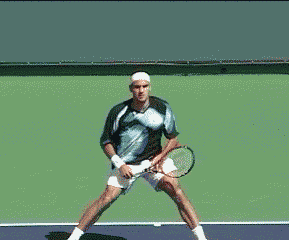

 Your comments are welcome. Let us know what you think about this article by
Your comments are welcome. Let us know what you think about this article by